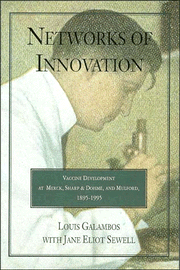Book contents
- Frontmatter
- Contents
- PREFACE
- 1 1894: “The foremost medical question of the day”
- 2 The Mulford Story
- 3 A Sharp & Dohme Interlude
- 4 The Virology Network and a New Program at Merck Sharp & Dohme
- 5 Hilleman's Innovations: First Phase
- 6 Dangerous Interlude
- 7 Transforming Bacteriology: A Second Phase
- 8 New Networks, New Leadership: The Hepatitis B Vaccines
- 9 Vaccine Innovation in the Nineties: New Strategies, New Opportunities, and Public Confrontations
- 10 Historical Perspectives on the Process of Innovation
- ACKNOWLEDGMENTS
- A WORD ABOUT SOURCES
- INDEX
- Plate section
6 - Dangerous Interlude
Published online by Cambridge University Press: 06 July 2010
- Frontmatter
- Contents
- PREFACE
- 1 1894: “The foremost medical question of the day”
- 2 The Mulford Story
- 3 A Sharp & Dohme Interlude
- 4 The Virology Network and a New Program at Merck Sharp & Dohme
- 5 Hilleman's Innovations: First Phase
- 6 Dangerous Interlude
- 7 Transforming Bacteriology: A Second Phase
- 8 New Networks, New Leadership: The Hepatitis B Vaccines
- 9 Vaccine Innovation in the Nineties: New Strategies, New Opportunities, and Public Confrontations
- 10 Historical Perspectives on the Process of Innovation
- ACKNOWLEDGMENTS
- A WORD ABOUT SOURCES
- INDEX
- Plate section
Summary
WHILE MERCK's virology operations were developing significant new products and pushing the firm into a strong position among the U.S. leaders in biologicals, the American economy was starting its bumpy descent from the prosperity of the American Century. The years 1965 through 1975 were crucial in this regard, but for some time it was difficult to perceive what was happening. Government expenditures for the Vietnam War and for the social welfare “butter” that President Johnson told the nation it could also afford gave a jump start to the national economy. Government contracts were available for many firms. Federal dollars flowed into the science and technology networks, including those in the medical sciences. But all the while, America's competitors were rapidly catching up with U.S. firms. Productivity increases in Europe and Asia were running substantially ahead of those in the United States. The Keynesian jump start also helped launch the Great Inflation – a development that further weakened the competitive position of U.S. firms. In 1973 the first oil shock made evident to the general public what many business executives already knew: the prosperous years of the American Century were over and the difficult years of intense global competition had begun.
On the surface, Merck & Co., Inc., appeared to be bucking this trend. Sales increased between 1970 and 1975 by more than 65 percent, reaching $1.26 billion by the latter year. Investors benefited from a two-for-one stock split in 1972, and the price of Merck stock went up by almost 54 percent during the first half of the 1970s. The company was putting more and more money into research and development, which boded well for the long-term future of the enterprise.
- Type
- Chapter
- Information
- Networks of InnovationVaccine Development at Merck, Sharp and Dohme, and Mulford, 1895–1995, pp. 123 - 150Publisher: Cambridge University PressPrint publication year: 1996



